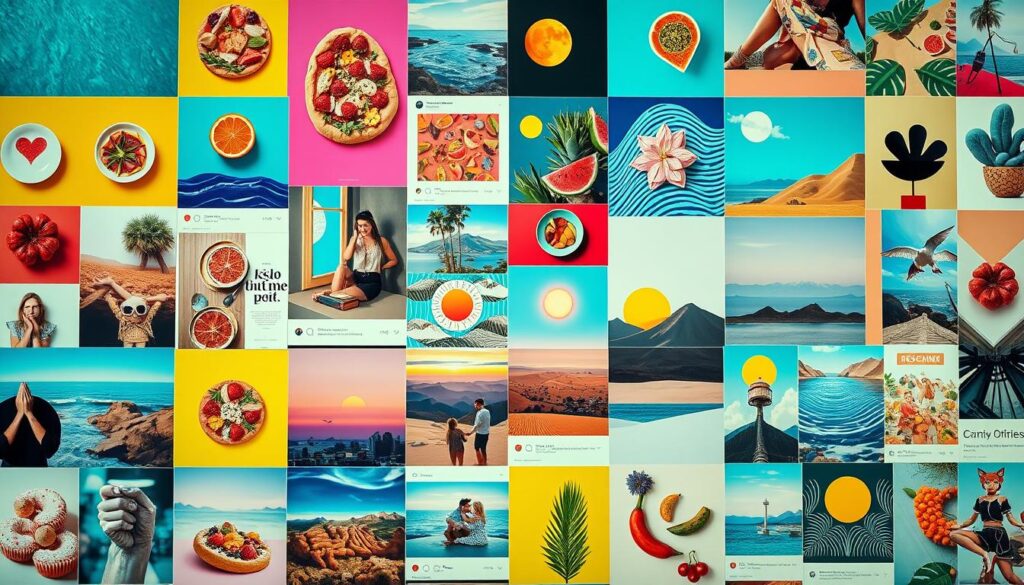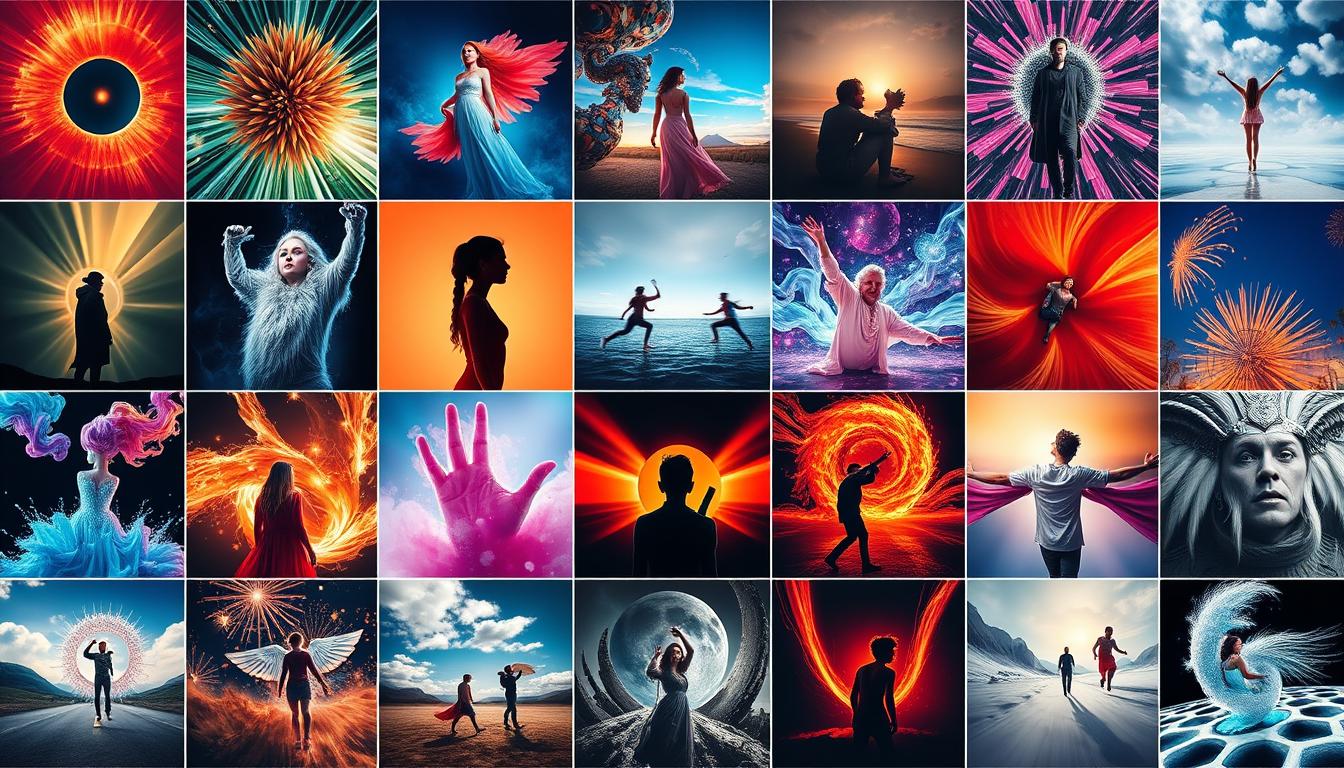Almost all brands use social media, with 94% of consumer and B2B marketers on Facebook and LinkedIn1. Yet, getting people to notice your brand is tough, with only 0.09% engagement on Facebook lately1. Most marketers use visuals to catch eyes, but many struggle to make content that stands out. This leads to too many stock photos that miss the mark1.
Key Takeaways
- Craft captivating copy and engaging storytelling to grab attention
- Utilize attention-grabbing headlines and emotional resonance
- Create compelling visuals that align with your brand and target audience
- Adopt a user-centric design approach to enhance engagement
- Leverage data-driven insights to optimize your content for conversion
To stand out on social media, brands need to craft content that stops people from scrolling. This means using great copy, stories, and visuals that touch your audience’s hearts. By focusing on what users want and using data to guide you, you can make content that not only catches eyes but also leads to real engagement and sales.
The Importance of Capturing Attention on Social Media
In today’s fast-paced social media world, grabbing users’ attention is key. Studies show that our attention spans have gotten shorter over time, making it harder to keep users engaged.2 With people quickly deciding what to look at and forming opinions fast, it’s vital to have content that grabs attention right away.2
To make users stop and look, content needs to be eye-catching and touch their feelings. Content that makes people feel happy, surprised, or amazed is more likely to get a reaction and engage users. This shows how important it is to make content emotionally appealing.2 Social media algorithms also look for content that is relevant, engaging, and recent. This means making sure your content is seen and interacted with as much as possible.2
Statistics on Social Media Usage and Challenges
You need to grab the viewer’s attention in the first three seconds to stop them from scrolling past your content.3 Many people keep their phones on silent, so videos might play without sound. On computers, videos might also start silently. This means a lot of viewers might watch ads without hearing them, so it’s key to make sure your message gets through silently.3
Social media feeds move fast, so visuals are key to catching someone’s eye quickly. So, making your content look good is important for getting people to engage with it.3 Titles and descriptions of ads help tell users what the content is about and give info to the platform’s algorithms for targeting. Using the right keywords is also important.3
To stand out in a busy feed, making ads that grab attention from the start can help you get noticed and be more competitive in social media ads.3

Create Content that Stops the Scroll
To make content that grabs attention, marketers can use several strategies. These include tapping into the brain’s survival instincts and using storytelling. By doing this, brands can make copy that stops users from just scrolling4.
Headlines that make you curious can really help. For instance, a title like “How a marketer generated over $10 million in pipeline revenue in three months as a one-person marketing team” gets people to click4.
Using eye-catching visuals is key too. Brands like Apple and Honest Co. use human faces in their content. This makes them more memorable and builds a strong emotional bond with their audience4.
User-centric design and data also play a big role. By knowing what their audience likes, brands can make content that meets their needs. This approach boosts conversion rates5.
For social media, videos and motion are powerful tools. Short videos and ads with animations grab attention well5.
By using these methods, brands can make content that stops the scroll. This leads to more engagement and conversions, making their marketing successful6.

Optimize Visual Content for Each Platform
Creating scroll-stopping content for social media needs a smart plan for visual design. It’s important to know the unique specs and how users act on each platform. This way, your captivating copy and engaging storytelling will look great and grab attention. By making your visuals fit each platform, you boost the emotional resonance and compelling visuals that pull in your audience.
Platform-Specific Image Dimensions and Requirements
Visual content needs to fit the bill on different social media sites. For instance, a tall image works well on Instagram but might not on LinkedIn. Designers should look into the user-centric design and data-driven insights for each platform. Then, they can tailor their visuals just right.
- On Instagram, the best image size is 1080 x 1080 pixels for square posts and 1080 x 1350 pixels for vertical posts7.
- Facebook likes images that are 1200 x 630 pixels big7.
- For Twitter, go with 1024 x 512 pixels for your images7.
- LinkedIn is best with a 1200 x 628 pixel image7.
- On Pinterest, tall images with a 2:3 or 4:5 ratio work best7.
Following these platform-specific requirements makes sure your visuals look good and helps your content marketing strategy work better.
Evoke Emotions through Visual Storytelling
Captivating visual content grabs the attention of people on social media. It uses engaging stories and visuals to connect with audiences8. Visual storytelling in B2B marketing makes complex ideas simple and boosts engagement8.
Knowing what different generations like on social media is key to reaching them8. Millennials and Gen Z use social media in different ways, with a focus on community and being active on LinkedIn8. It’s important to tailor your visuals to fit each platform, like using quality photos on LinkedIn and real footage on TikTok8.
Motion elements like GIFs and videos grab attention and keep users interested8. Short videos on TikTok and Instagram Reels are great for quick, engaging content8. Interactive features, like photo carousels, get people involved and make stories more engaging8.
Visual storytelling stirs emotions and builds a strong bond between brands and their audience9. People remember about 95% of a message if it’s shown visually, compared to just 10% in text form9. Images make content 94% more likely to be viewed, and Facebook posts with pictures get twice the traffic of those without9.
Creating visuals that match what your audience likes can make your brand more engaging and meaningful9. 53% of consumers want more video from brands they support, and 89% bought something after watching a video9.
Visual storytelling is a powerful tool in content marketing. It helps brands stand out, grab attention, and build deeper emotional connections with their audience.
Embrace Imperfection for Authenticity
In today’s world, social media often shows perfect lives. Embracing imperfection can make your content stand out. A “poorly designed” image or an “imperfect” post can catch more eyes than a perfect one. This is because it feels real and relatable1011.
Always trying to be perfect can make it hard to connect with others. People might focus on looking flawless10. But, showing your true self and your flaws can make your relationships stronger10.
Chasing perfection can hurt your mental health too. It can make you feel not good enough and doubt yourself10. By accepting imperfection, you can make your content feel more real and touching11.
To find the right mix of polished and real, try these tips:
- Showcase behind-the-scenes moments: Share real, unedited parts of your life or work. Let people see the real you.
- Embrace off-center or “imperfect” visuals: Try making your photos feel more spontaneous and real, not too perfect.
- Respond gracefully to mistakes: When things go wrong, use it as a chance to connect with your followers and show your true self.
By being real and showing your true self, you can make scroll-stopping content, captivating copy, and engaging storytelling. This will make your audience feel closer to you1112.
Being brave and showing your true self can be a strong way to build emotional resonance and genuine connections with your followers12.
Scroll-Stopping Content
In the world of social media, grabbing attention is key. To do this, focus on making scroll-stopping content. Use captivating copy, engaging storytelling, and attention-grabbing headlines that touch people’s feelings and give real value to your followers13.
Use compelling visuals and user-centric design to make your content pop. Companies with blogs get 55% more website visitors and 67% more leads13. Make sure your visuals fit each platform’s style, matching your data-driven insights and conversion optimization plans13.
Being real and okay with imperfection helps connect with people. Start videos with something amazing to stop people from scrolling14. Show off your brand’s culture and values with employer branding videos that speak to your audience14.
The key to scroll-stopping content is knowing your audience and giving them valuable and educational content. Use data-driven insights to improve your strategy. By focusing on visual composition and hierarchy, you can create a user-centric experience that keeps people interested and engaged131415.
Provide Value through Educational Content
In today’s busy social media world, scroll-stopping content is crucial to grab attention. Sharing educational content that truly helps your followers is a great way to stand out. By focusing on teaching and enlightening, you can make your content both captivating and engaging.
Examples of Engaging Educational Content
There are many ways to share knowledge, like infographics and carousel posts. The main thing is to use attention-grabbing headlines and compelling visuals to catch your audience’s eye right away16.
Using a user-centric design helps make your content hit home with your audience. Webinars, tutorials, and product review videos are great for showing you’re a leader in your field. They also help build customer loyalty17.
The aim is to give value, not just promote. By educating and informing your audience, you create scroll-stopping content that boosts conversion optimization. This supports your content marketing strategy1617.
Master Visual Composition and Hierarchy
Making social media content that stops people from scrolling needs a good grasp of visual composition and hierarchy. The design should grab the user’s attention, focusing on the most important messages. Creating a clear hierarchy, where key messages stand out, and adding more details around it, is crucial for making social media designs that stop the scroll.18
Using size, color, and contrast can really grab the viewer’s attention. Big elements and bright colors stand out on social media19. Properly aligning design elements also helps guide the viewer’s eyes to the most important parts19.
- Use visual hierarchy to make content stand out and guide the viewer’s eyes. The F-Pattern and Z-Pattern can help focus attention19.
- Apply color theory to create the right feelings and show your brand’s personality. Warm colors like red and orange bring energy, while cool colors like blue and green show calmness20.
- Choose captivating typography that fits your brand’s voice and improves the look. Think about font type, size, spacing, and arrangement for easy reading and good design20.
- Add textural elements to make your designs more interesting and engaging. This adds depth and meaning to your stories20.
By understanding visual composition and hierarchy, you can make scroll-stopping content that grabs your audience, stirs feelings, and boosts engagement on social media181920.
Focus on the Audience’s Needs
Creating great social media content means focusing on what the audience wants, not just what the brand offers. Jamahl Johnson of 99Designs says people follow brands for different reasons, like info, fun, or inspiration. It’s the brand’s job to deliver what they’re looking for21. By making content that matters to the audience, brands can grab their attention and build strong connections.
Strategies for Audience-Centric Content
Here are some ways to make your content all about the audience:
- Leverage data-driven insights: Use data to learn about your audience’s likes, dislikes, and needs. This helps you make content that really speaks to them22.
- Embrace emotional resonance: Emotional stories can create a strong bond with your audience. Write headlines and content that makes people feel good, building trust and loyalty21.
- Provide value-added content: Share content that teaches, informs, or entertains. This approach makes your brand a go-to source for your audience’s problems, boosting engagement23.
- Encourage audience participation: Get your audience involved with interactive posts, user content, and contests. This builds a community and spreads your content further23.
By focusing on what the audience wants, brands can stand out in the crowded social media space. This approach is key to a winning content marketing strategy.
Test, Analyze, and Refine
Making great social media content is a process of testing, analyzing, and refining. By watching the data and trying new things, marketers can find the best ways to connect with their audience and get results24.
Knowing your audience is key, as ads that speak directly to them can boost conversions by 10%24. Headlines that grab attention can lead to a 30% jump in clicks24. And visuals are crucial, as posts with pictures get 94% more views than those without24.
Using clear calls-to-action (CTAs) is vital, as tailored CTAs can improve conversions by 202%24. User reviews can also increase conversions by up to 270%24. Testing different versions of ads can lead to a 32% boost in conversion rates on average24.
To make content that stops people in their tracks, marketers can use various hooks25. These hooks grab attention, spark curiosity, and help build stronger connections with the audience25. By testing, analyzing, and refining these hooks, businesses can improve their social media and get better engagement and conversions25.
For online stores, important metrics include click-through rates, conversion rates, and return on ad spend26. Testing different content elements can reveal what works best. Making sure your site works well on mobiles and keeping a consistent brand helps with engagement and trust26. Using content from users, telling stories, and focusing on specific audiences can also make your social media content more effective26.
By using data and refining their strategies, marketers can make social media content that really grabs their audience’s attention. This leads to clear results and success over time242526.
Conclusion
Making scroll-stopping content is all about using many strategies together. This includes making people feel something and telling stories that grab their attention. It also means using eye-catching visuals and thinking about what the audience likes. By testing and improving their content, marketers can make social media posts that really connect with people, making their brand stand out27.
It’s key to write attention-grabbing headlines and tap into emotional resonance to stop people from scrolling. Using data-driven insights and conversion optimization can also make the content more effective2728.
By getting better at these skills and always improving, marketers can make social media content that not only grabs attention but also leads to real engagement and business success. The secret is to stay flexible, focused on what the audience wants, and keep the content fresh, useful, and impactful in the fast-changing world of social media2728.
FAQ
What is the current state of social media usage for brands?
How can marketers create content that stops the scroll on social media?
Why is it important to optimize visual content for each social media platform?
How can brands use visuals to evoke emotions and build connections with their audience?
Why is it important to find a balance between polished and authentic visuals?
What makes for effective scroll-stopping social media content?
How can brands use data to optimize their social media content?
Source Links
- https://www.convinceandconvert.com/social-media/visual-content-for-social-media/
- https://roseandgold.com/the-science-of-scrolling-understanding-user-behavior-on-social-platforms/
- https://www.hop.online/blog/social-media-ads-stop-the-scroll
- https://www.linkedin.com/pulse/how-create-scroll-stopping-content-ramli-john
- https://nogood.io/2022/10/21/stop-the-scroll/
- https://www.shieldapp.ai/blog/how-to-write-a-scroll-stopping-post
- https://www.doola.com/blog/top-20-tools-for-creating-scroll-stopping-visual-content-in-2024/
- https://1827marketing.com/smart-thinking/how-to-master-scroll-stopping-visual-content-for-b2b-social-media-marketing
- https://foundationinc.co/lab/visual-storytelling
- https://www.psychologytoday.com/us/blog/conquering-codependency/202102/embrace-your-imperfections
- https://stepoutbuffalobusiness.com/imperfection-is-trending-on-social-media-heres-how-to-do-it-perfectly/
- https://uncovercounseling.com/blog/navigating-perfectionism-in-the-age-of-social-media-comparison/
- https://scrollstoppingcontent.com/
- https://kwsmdigital.com/blog/6-tactics-to-create-scroll-stopping-video/
- https://eightclients.com.au/scroll-stopping-strategy/
- https://wearesherose.com/20-scroll-stopping-content-ideas-for-you/
- https://www.whyarticulate.com/insights/video-marketing
- https://visme.co/blog/visual-hierarchy/
- https://www.interaction-design.org/literature/topics/visual-hierarchy?srsltid=AfmBOopCLj5L1M2OjDtW3JPTMKRX8qeIs0OMg3waZVMbu_8VYEUTzODA
- https://blog.emb.global/role-of-design-concepts-in-visual-communication/
- https://coolerinsights.com/2021/09/how-to-create-scroll-stopping-social-media-content/
- https://erinpennings.com/captivating-your-audience-8-best-practices-for-a-scroll-stopping-hero-section-that-converts/
- https://jessequagraine.medium.com/8-interesting-content-ideas-to-make-your-audience-stop-the-scroll-b2b59b930b4c
- https://www.gravitatedigital.com.au/blog/crafting-scroll-stopping-ads
- https://www.laurapaulina.com/info/110-scroll-stopping-social-media-hooks
- https://adnativia.com/blog/scroll-stopping-content-the-secret-sauce-of-e-commerce-native-ads/
- https://anamikasharmaa.medium.com/best-tip-to-write-scroll-stopping-content-61f0c944fce2
- https://creatify.ai/blog/6-tantalizing-tips-to-create-scroll-stopping-product-videos








